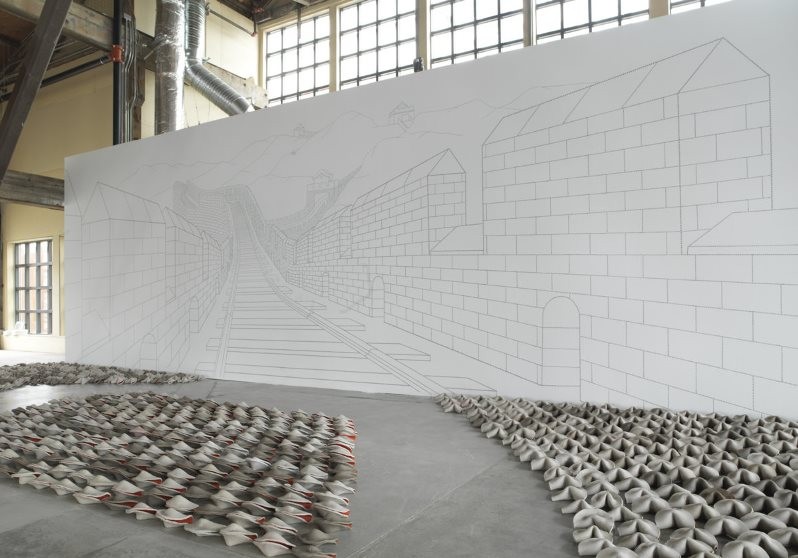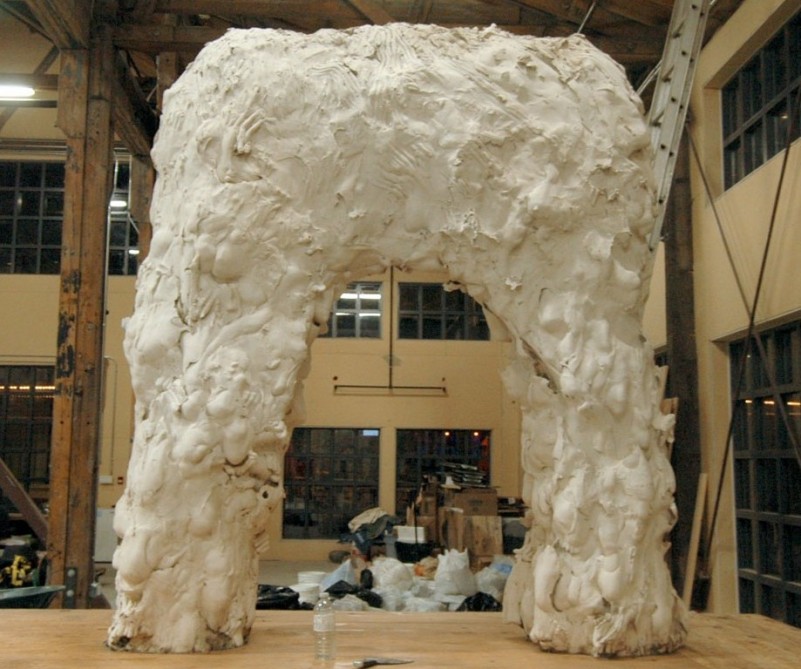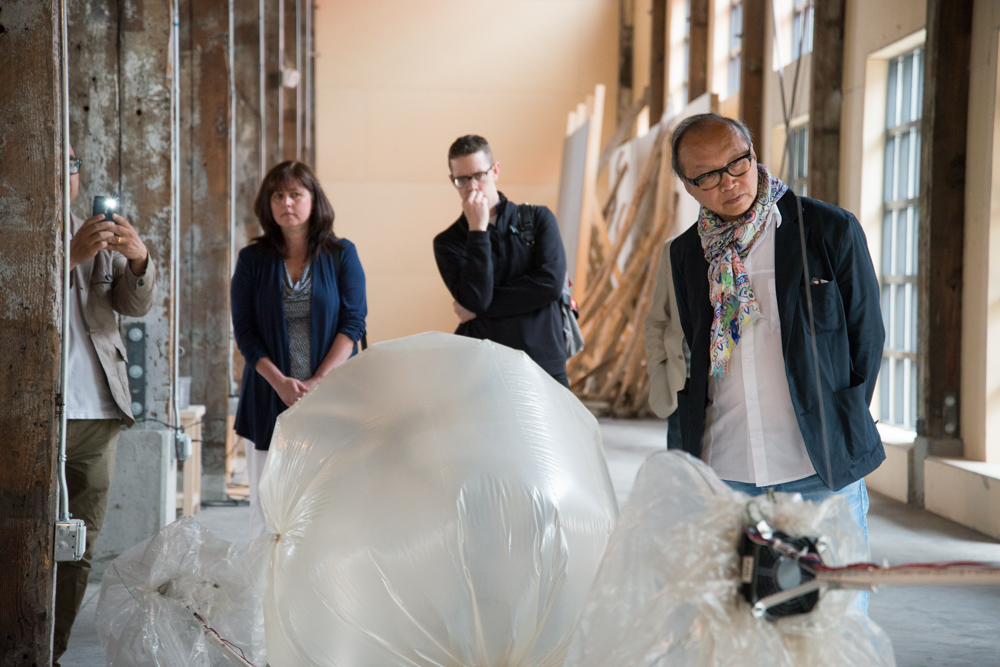Connecting the Arts to Indigeneity: The Red Cedar & Totems
Social Studies - Grade 5
This inquiry challenge is intended to be used in connection with the full set of cross-curricular, multigrade inquiry challenges written for the entire Pavilion exhibition. The related unit plans are listed as “Related Material”. This unit of inquiry is not a recipe book but rather a launchpad to inspire new BIG IDEAS. We encourage you to use and/or modify one, or several of the BIG IDEAS below. Adapt it to the grade/ ability level of your students.
Enduring Understanding
Artwork has the power to reflect the stability and instability of culture, economy, government both past and present.
Guiding Questions for the entire Pavilion:
In what ways can stigmatism be broken down and perception be changed about a nation? How would you describe the current state of affairs in Brazil? What are the collective voice of the Brazilian contemporary artists? How does the current state of affairs in Brazil relate to life in Vancouver, Canada and the world?
Guiding Questions for this installation (Arbor-Vitae by Marcelo Moscheta)
How does Moscheta’s use of the western Red Cedar in his artwork relate to Northwest Coast First Nation’s use of the same tree?
Mind Opening
Choose or devise practices to encourage students to be open to new experiences and ways of thinking in your classroom. For example, the MindUP in-school program.
Discovery and Inspiration:
Launch the Project
• Introduce the Theme: Present the Enduring Understanding and Guiding Questions using vocabulary that is appropriate for your grade level.
• About Vancouver Biennale: Play a short video.
• Create Project Space: Brainstorm ideas to make the project theme visual and visible using bulletin boards, and/or a project corner to share relevant materials and inquiry questions and processes.
Reference Resources:
• 2014-2016 Exhibition Theme: Open Borders / Crossroads Vancouver
• Biennale International Pavilion/Focus on Brazil: for Information about the Pavilion
• Unit Plan Feature Artist: Arbor-Vitae by Marcelo Moscheta
• Related Unit Plans: Brazil’s Current State of Affairs, Rainfall in Vancouver & São Paulo, Relating Art to the Human Body, Relating Art to the Written Word, Tension in Canadian History
• Other Pavilion Brazilian Artists: Paulo Climachauska, Nathalia Garcia, Juliana Cerqueira Leite, Mariana Manhães, Gisela Motta & Leandro Lima, Raul Mourão, Tulio Pinto, Studio in the City
Behind the Scene Making of the Pavilion Video
Learning to Learn:
Art Inquiry
• Ask students to write in their journal and share how would they describe the culture of Brazil before visiting the Pavilion and indicate how did they form these impressions. After the visit, ask the students if their perceptions have changed and if so, in what ways.
• BIG IDEAS Anywhere educators: Experience the Pavilion anytime and its thought provoking Brazilian art here using a 3D Navigator/Viewer – you can walk around the space with your mouse and interact with the art as if you are there! For best virtual art inquiry experience, freely explore the Pavilion and locate Arbor-Vitae (Marcelo Moscheta) for further inquiry challenges. Interact and experience with this installation from different angles using the 3D Navigator/Viewer. Also view the Pavilion Guided Tour Video segment about this artwork (from 6:41 to 7:28 min) MUTE ON.
• Use the Art Inquiry Worksheet to guide and capture their ideas and impressions. Customize or create your own Art Inquiry Worksheet as appropriate for your project and class needs.
• Click the Box Below to begin your Pavilion Virtual Exploration via 3D Navigator/Viewer provided by Real Estate Channel (Contact: [email protected])
Shared Insights
• Sharing Art Inquiry Experience: Ask students to share the Art Inquiry Worksheet responses in class.
• View Guided Tour Video: View the Pavilion Guided Tour Video introductory segment and segments about this artwork (from 0 to 1:15, 6:41 to 7:28 min) again with SOUND ON.
• Significant Aspects of the Artist’s Life & Work : Using the following information on Marcelo Moscheta, the teacher creates stations detailing the artist’s life and work. In small groups students rotate through these stations. Topics might include: (1) education and training; (2) life’s work; (2) materials and processes; (3) beliefs and values. At each station, students answer questions and/or complete tasks. For example, at the station “life’s work” students might plot the artist’s various installations on a map of the world. Encourage students to draw a parallels to their own life and reflect on the countries/cities/communities that they have lived and the significance of each location to them.
• Artist Themes: Connecting People Across Borders & Indigenous Ways of Knowing: How might similarly themed artwork connect people across borders? Interconnection is at the core of First Nations, Inuit and Métis ways of knowing. This UNESCO site describes Indigenous world-views. Prepare a Jigsaw activity that introduces students to Indigenous ways of knowing in relation to human interconnectivity. Students do a think, pair, share activity that unpacks what human interconnectedness means to them. Once in their “share” groups of four they then discuss the following question: How might similarly themed artwork throughout the world connect people worldwide? Students extend this thinking by drafting a (text, visual, media) response to this question. These drafts are peer edited to revise ideas, organization, voice, word-choice and sentence fluency.
• Artist Themes – Tree of Life: Bring up the western Red Cedar being British Columbia’s official tree. Moscheta uses this provincial symbol to explore intersection of memory, history and landscape. Ask students to research the connections between the Red Cedar Tree and our local geography and history and each student to share one key connection in groups. Ask students to research if there is an official tree in Brazil where Moscheta comes from.
Cross-Curricular Inquiry Challenges
Arbor-Vitae (Marcelo Moscheta) Inquiry Challenge
How does Moscheta’s use of the western Red Cedar in his artwork relate to Northwest Coast First Nation’s use of the same tree?
• Social Studies – Indigeneity & Totem Poles:
1/ Students View the National Film Board (NFB) documentary entitled Totem: The Return of the G’psgolox Pole. You can view the film in its entirety on the NFB website, here. 2/ Teacher shows selected images of Northwest Coast Totem poles and asks students to work in pairs on KWL Worsheet detailing what they know and want to know about totem poles. 3/ Using the resources below, and the following Totem Pole Summary Worksheet, the teacher introduces and provides more background information on totem poles. 4/ Students then fill out their KWL Worsheets again detailing the new information they have acquired. 5/ Using Jigsaw style cooperative learning groups research one of the six types of totems: 1. Mortuary Poles; 2. Memorial Poles; 3. Heraldic Portal or Family Poles; 4. Potlatch Poles; and 5. Ridicule or Shame Poles. 6/ Groups will report back to the class and students will complete their Type of Totem Charts. Groups then choose on pole and using the concept the concept of Historical Evidence answer the following questions: When was this work produced? What might have been the artist’s purpose in producing this art? Who do you think is the intended audience? What do you think is the intended message? What was going on in the society where this artwork was created that might help us interpret the artwork? How might this context help use understand what life was like for the people in the artwork?What materials has the artist used? Is there special significance to these materials? What symbols or metaphors does the artist use to accomplish this?
Possible extension: Students research a contemporary First Nations totem carver and fill in the final column of their worksheet to explain what the artist’s poles are used for today. Some contemporary carvers include:
Bill Reid (CBC news)
OTHER RESOURCES:
North American Northwest Coast Totems
Totem Poles of the North American Northwest Coast Indians
Canadian Museum of History – Grand Hall
Totem Poles An Exploration by Pat Kramer
Totem Pole Raising Ceremony Photos and Commentary – White Rock Elementary School, White Rock, B.C.
www.crescentbeach.bc.ca/TOTEM/html/carver/carv/raising/raiseE/raisin_E.htm
Totem Pole Raising Ceremony – University of Alaska Southeast
vimeo.com/11303883
Totem Poles – National Film Board
www.nfb.ca/explore-by/keyword/en/totem_poles/
Totem Poles: An Exploration by Pat Kramer
users.imag.net/~sry.jkramer/nativetotems/
Totem Pole Photos – SFU Museum of Archaeology and Ethnology
www.sfu.ca/archaeology/museum/totempoles/totem_home.htm
Books & articles
Barbeau, M. Totem Poles of the Gitksan, Upper Skeena River, British Columbia. Ottawa: F.A. Acland, 1929. National Museum of Canada, Anthropological Series, No. 12. Bulletin No. 61. Part of an anthropological series with very complete factual information.
Barbeau, M. Totem Poles, Totem Poles according to crest and topics. Canada: Dept. of Resources and Development branch of the National Museum of Canada. Bulletin No. 119, Vol. I., Anthropological series #30.
Barbeau, M. Totem Poles, Totem poles according to location. Canada: Dept. of Resources and Development Branch of the National Museum of Canada. Bulletin No. 119, Vol. II, Anthropological series #30.
Black, M. Totem Poles in the Royal BC Museum. Royal British Columbia Museum. Victoria, B.C.
www.royalbcmuseum.bc.ca/content_files/files/totempoles.pdf
Csikazentmihalyi, M. & Rochberg Hulton, E. (1981) The Meaning of Things: Domestic Symbols and the Self . Cambridge: Cambridge University Press.
Garfield, V. E. & Foreest, L. A. (1961). The Wolf and the Raven. Seattle: University of Washington Press. Interesting reading.
Jensen, V. The Totem Poles of Stanley Park. Vancouver: Westcoast Words and Subway Books, 2004.
Jonaitis, A. & Glass, A. The Totem Pole: An Intercultural History. Seattle: University of Washington Press, 2010.
Keithahn, E. L. (1963) Monuments in Cedar. Seattle, Washington: Superior Publishing Co.,
Kramer, Pat. Totem Poles. Calgary: Altitude Publishing, 2004.
Ramsay, H. Totem Poles: Myth and Fact.(2011) The Tyee. 31 March, 2011.http://thetyee.ca/Books/2011/03/31/TotemPoles/
Stewart, H. Looking at Totem Poles. (1993) Vancouver: Douglas and McIntyre.
Legend Picture Books:
• Mayuk: The Grizzly Bear A Legend of the Sechelt People. Nightwood, Editions ISBN 0-88971-156-9
• Salmon Boy A Legend of the Sechelt People. Nightwood, Editions ISBN 0-88971-166-6
• Lewis, P. Frog Girl. Published by White Cap Books ISBN 1-55285-193-1
Reflection
• Teacher and students can reflect on their entire learning process by revisiting the Enduring Understanding and relevant Guiding Questions.
• How did the unit of study open inquiry, create cross–curricular learning opportunities and/or apply learning to real life situations? Has this unit of inquiry changed your opinions, values and world view? In what ways, if any, has it helped you grow as a learner?
Credits
Written by: Stephanie Anderson Redmond, B.A.; B.Ed.; M.Ed.; Ph.D.Student, Department of Curriculum and Pedagogy, UBC
©2014 Vancouver Biennale





